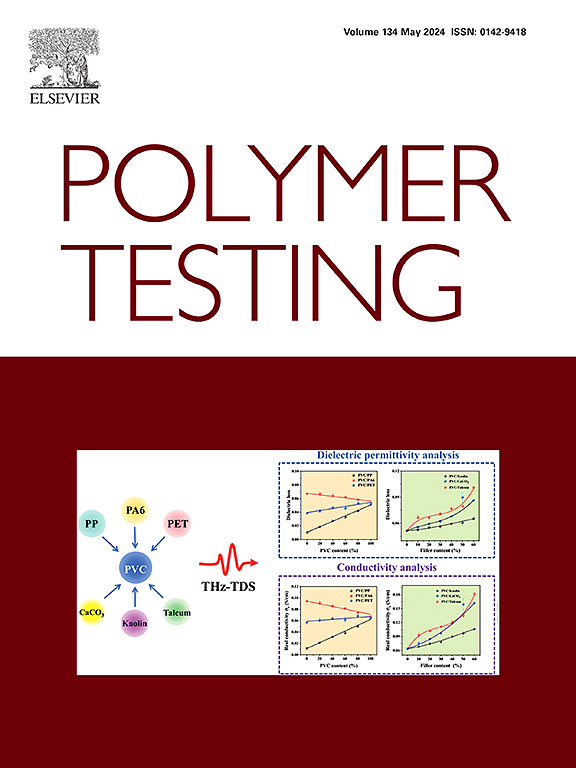Deciphering the crosslink mechanism of dual cure EP(D)M and CTS rubber compounds for reduced oil swell
IF 5
2区 材料科学
Q1 MATERIALS SCIENCE, CHARACTERIZATION & TESTING
引用次数: 0
Abstract
Rubber compounds containing blends of two or more polymers are common in various industrial applications, starting with the tire industry. Blends are most commonly comprising of materials that are compatible with each other. However, for blends that are comprising of polymeric materials with limited compatibility, understanding the limitation and ways to overcome it is paramount to ensuring rubber compounds homogeneity. In this study Ethylene Propylene (Diene) Polymer (EPDM) or Ethylene Propylene Polymer (EPM) and Cyclic Tetrasulfide (CTS) are combined with the goal of achieving a compound that has superior properties than EPDM or EPM. Thermodynamic studies are deployed to illustrate materials' compatibility. The role of CTS in the compound is discussed in detail, as it presents dual functions. This study represents a fundamental analysis of EP(D)M-CTS blends, starting with Thermodynamic studies and polymeric phase analysis by Scanning and Transmission Electron Microscopy (S(T)EM) hyphenated by Energy-Dispersive X-ray Spectroscopy (EDX) or Raman Spectroscopy. The resulting rubber compounds' mechanical properties are analyzed, including the Payne effect. The compound resistance against swelling when exposed to a standard hydrocarbon oil was tested on a side-by-side comparison with pure EPD and they show positive outcome. EPDM-CTS compounds have an increased resistance to swell in standard hydrocarbon oil. This feature is important in rubber articles such as for o-rings, gaskets, and other seal articles. The focus of this study is to elucidate the mechanism of crosslinking in rubber compounds comprising of EP(D)M and CTS. This fundamental understanding of the crosslinking chemical process signifies the building block for future EP(D)M-CTS compound development.
解读双硫化EP(D)M和CTS橡胶化合物的减油交联机理
橡胶化合物含有两种或两种以上聚合物的混合物,从轮胎工业开始,在各种工业应用中很常见。共混物通常由相互兼容的材料组成。然而,对于由相容性有限的聚合物材料组成的共混物,了解其局限性和克服它的方法对于确保橡胶化合物的均匀性至关重要。在本研究中,乙烯丙烯(二烯)聚合物(EPDM)或乙烯丙烯聚合物(EPM)和环四硫化物(CTS)相结合,目的是获得比EPDM或EPM具有优越性能的化合物。热力学研究被用来说明材料的相容性。详细讨论了CTS在化合物中的作用,因为它具有双重功能。这项研究代表了EP(D)M-CTS共混物的基本分析,从热力学研究和聚合物相分析开始,通过扫描和透射电子显微镜(S(T)EM),再加上能量色散x射线光谱(EDX)或拉曼光谱。分析了所得橡胶化合物的力学性能,包括佩恩效应。当暴露于标准碳氢化合物油时,该化合物的抗膨胀性与纯EPD进行了并排比较,结果显示出积极的结果。EPDM-CTS化合物在标准烃油中具有更高的抗膨胀性。这一特性在橡胶制品中很重要,如o形圈、垫片和其他密封制品。本研究的重点是阐明由EP(D)M和CTS组成的橡胶化合物的交联机理。这种对交联化学过程的基本理解为未来EP(D)M-CTS化合物的开发奠定了基础。
本文章由计算机程序翻译,如有差异,请以英文原文为准。
求助全文
约1分钟内获得全文
求助全文
来源期刊

Polymer Testing
工程技术-材料科学:表征与测试
CiteScore
10.70
自引率
5.90%
发文量
328
审稿时长
44 days
期刊介绍:
Polymer Testing focuses on the testing, analysis and characterization of polymer materials, including both synthetic and natural or biobased polymers. Novel testing methods and the testing of novel polymeric materials in bulk, solution and dispersion is covered. In addition, we welcome the submission of the testing of polymeric materials for a wide range of applications and industrial products as well as nanoscale characterization.
The scope includes but is not limited to the following main topics:
Novel testing methods and Chemical analysis
• mechanical, thermal, electrical, chemical, imaging, spectroscopy, scattering and rheology
Physical properties and behaviour of novel polymer systems
• nanoscale properties, morphology, transport properties
Degradation and recycling of polymeric materials when combined with novel testing or characterization methods
• degradation, biodegradation, ageing and fire retardancy
Modelling and Simulation work will be only considered when it is linked to new or previously published experimental results.
 求助内容:
求助内容: 应助结果提醒方式:
应助结果提醒方式:


